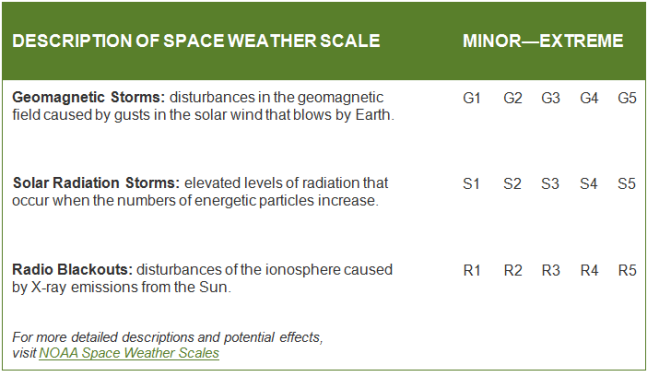
Space weather prediction services in the United States are provided primarily by NOAA's Space Weather Prediction Center (SWPC) and the U.S. Air Force's (USAF) 557th Weather Wing, which work closely together to address the needs of their civilian and military user communities. The SWPC draws on a variety of data sources, both space and ground-based, to provide forecasts, watches, warnings, alerts, and summaries as well as operational space weather products to civilian and commercial users. Sign up to receive email watches, warnings, alerts and more. The following are definitions of a Watch, Warning, and Alert:
Watch: A Watch is issued when the risk of a potentially hazardous space weather event has increased significantly, but its occurrence or timing is still uncertain. It is intended to provide enough advanced notice so those who need to set their plans in motion can do so. The purpose of a Watch is to give preliminary notification of possible space weather activity with a lead-time of hours to days. A Watch can be upgraded to a higher-level Watch.
SWPC only issues Watches for geomagnetic storm events at the G1 to G4 or greater levels from 1 to 3 days in advance. For Warnings: SWPC currently issues Warnings for S1 expectations and G1 to G3 or greater levels. For Alerts: SWPC issues Alerts for each G1 - G5 level as reached every 3 hours; S1 - S5 levels as they are reached; and for R2 level flares when reached.
Warning: ;A Warning is issued when a significant space weather event is occurring, imminent or likely. A Warning is a short-term, high confidence prediction of imminent activity. The purpose of a Warning is notification of impending space weather activity with a lead-time of minutes to a few hours. A Warning can be upgraded to a higher Warning if space weather conditions are expected to change sufficiently enough to warrant the upgrade.
Alert: Alerts indicate that the observed conditions, highlighted by the warnings, have crossed a preset threshold or that a space weather event has already started.
The NOAA Space Weather Scales report three categories of solar effects. These scales communicate current and future space weather conditions, and their possible effects on people and systems. Similar to the Saffir-Simpson Hurricane Wind Scale and the Enhanced Fujita (EF) tornado wind scale, the NOAA space weather scales correlate space weather events with their likely effects on technological systems. As shown in the table above, the scales describe the environmental disturbances for three event types: Geomagnetic Storms (G-scale), Solar Radiation Storms (S-scale), and Radio Blackouts (R-scale). The scales have numbered levels, analogous to hurricanes, tornadoes, and earthquakes, that convey severity.